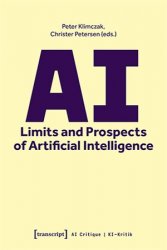 Название: AI: Limits and Prospects of Artificial Intelligence
Название: AI: Limits and Prospects of Artificial IntelligenceАвтор: Peter Klimczak, Christer Petersen (eds.)
Издательство: Transcript Publishing
Год: 2023
Страниц: 291
Язык: английский
Формат: pdf (true)
Размер: 10.2 MB
The emergence of Artificial Intelligence has triggered enthusiasm and promise of boundless opportunities as much as uncertainty about its limits. The contributions to this volume explore the limits of AI, describe the necessary conditions for its functionality, reveal its attendant technical and social problems, and present some existing and potential solutions. At the same time, the contributors highlight the societal and attending economic hopes and fears, utopias and dystopias that are associated with the current and future development of Artificial Intelligence.
Intelligent machines and algorithms, mostly subsumed under the name of Artificial Intelligence (AI), are pervading ever more areas of modern life. In doing so, they are increasingly presenting results that exceed the capabilities of humans in the respective area of application. Examples are Alpha Go in the Asian game of Go, AI-based chess computers, ChatGPT or the Watson system in the television show Jeopardy. But what can really be concluded from such results with respect to the capabilities of Artificial Intelligence?
One of the great challenges of analyzing Artificial Intelligence with regard to such a question is that – outside of certain formal rules – nobody knows the why, that is, for what reason the algorithms in question learn, i.e. how they finally acquire their capabilities and why they act as they act. This is especially true for learning algorithms based on neural networks as explainable AI still remains the exception in this area, even though research in explainable AI is currently starting to mushroom.
First, neural networks in general are discussed. Also, important definitions are formulated which prepare the groundwork for the following analyses but also limit the field of analysis. In the next chapter, learning algorithms are discussed, especially those that have been employed in cases where the performance of Artificial Intelligence compared to human intelligence is discussed. This part of the paper deals with these general questions by making use of the example of AlphaZero. This learning algorithm has been chosen, as chess has long since been regarded as the “drosophila” of AI. Unlike other chess programs, AlphaZero is based on a “general reinforcement algorithm”. This suggests that it could be “strong AI” because the principle can be applied easily to other games, as well as strategic situations – in fact, however, the historical course of events was the other way around. An application to the board game Go took place first and only after it was surprisingly successful in that domain was the principle later transferred to chess and shogi.
Скачать AI: Limits and Prospects of Artificial Intelligence